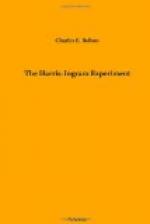Gertrude insisted, since the fog was lifting, that George should hitch his horses and for five minutes go with her up on the college tower. As they looked out, Gertrude said, “Here, George, on the west are our half dozen cozy college houses; on the smooth green lawn below you see our tennis-courts, and an abundance of shade.
“Now, George, turn to the east and see how kindly the sun has removed the mist and made for us a glorious day. How bright the colors in our flag that floats over the high school yonder! There stands the Soldiers’ Memorial Hall, the Edwards Church with graceful spire, and across the green meadows, with its winding stream of silver, rise the ranges of Mt. Tom and Mt. Holyoke, outlined in curves against the blue sky.”
“Beautiful!” responded George, “and yet, Gertrude, nothing in nature is half so lovely as your own dear self.” Without warning he kissed her rosy cheek, her whole face changing to crimson as she said, “George, we must be going.”
Two happy young souls drove away from Smith College out under the Gothic elms, where the birds were mating and building their nests. The plan for the day was to drive to the mountain, and follow the mother and sister on the evening express to New York. The hotel clerk had pointed out the best road to Mt. Holyoke, and following his directions they drove southeast, leaving behind them shady Northampton, Smith College, and delightful memories of Jonathan Edwards, George Bancroft, and others.
A single white parasol was quite enough to protect two lovers from the sun’s rays. Circular shadows, photographs of the sun, frolicked with each other in the roadway as gentle breezes swayed the overhanging boughs.
Milk wagons with noisy cans were returning home, herds of black and white Holstein-Friesian cattle, famous for their yield of milk, were cropping sweet grasses in the pastures. Farmers were guiding their cultivators and mowing machines, while wives and daughters were shelling June peas, hulling strawberries, and preparing for dinner. The large white houses, with roomy barns in the shade of big elms, were the happy homes of freemen. Gertrude wanted the horses to walk more, but George was unwilling to take the dust of wagons returning from the market, so he kept the horses moving at a brisk pace.
At length the Hockanum Ferry with its odd device was reached. George got out and led the horses into the middle of the small river craft. Then the boat was pushed off and a strong man and boy pulled at the wire rope. The ferryman’s shanty, the willows, and tangled driftwood on the shore, fast receded, and soon the middle of the Connecticut River was reached, where the current is swiftest. In sight were several canoes with light sails, scudding before the wind. It seemed as if the tiny rope of the ferry would break, but the rope is of steel wire and the boat moved slowly till the opposite bank was reached. Gertrude held the lines, the sun shining full in her face, and talked to the boatman, to George, and the horses, but George said little as he was busy quieting the excited animals and studying the primitive rope-ferry.




